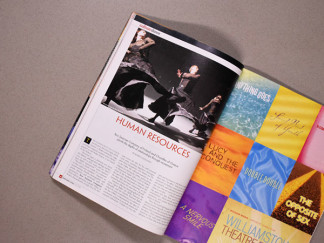As a freelance journalist, one of “hats” I most look forward to wearing is dance writer. A former dancer, I enjoy combining my interests and knowledge to write about a variety of dancers, choreographers, and companies. This story for Berkshire Living magazine, about visionary choreographer Tero Saarinen’s groundbreaking Borrowed Light and the up-and-coming Greek company Choreftes, is a personal favorite.
Human Resources
Tero Saarinen Company of Finland Choreftes of Greece plumb the depths of relationships through dance
By Robin Catalano
Tero Saarinen wants you to know that his piece Borrowed Light, which features a Shaker-minimalist stage and Shaker-inspired costumes, and is choreographed to old Shaker hymns, is not based on the Shakers.
“Borrowed Light is definitely not about the Shakers, although their ideology and history, as well as their music and art, [have] been highly inspirational,” he insists. “This piece is clearly a study of a community that could exist anywhere.” Saarinen, a multiple-award-winning Finnish choreographer and artistic director and performer with the eponymous Tero Saarinen Company, which will be appearing at Jacob’s Pillow in Becket, Massachusetts, on July 19 to 23, first came across the idea for his well-reviewed work when watching legendary choreographer Doris Humphrey’s The Shakers on TV in the 1980s. He collected material on the religious sect during the 1990s, and in doing so discovered Simple Gifts, a CD of Shaker music by the lauded Boston Camerata, and this gave him the final push to bring to life the ideas that had been simmering on his mental back burner for more than a decade.
Saarinen, who has choreographed for the Lyon Opera Ballet, the Ballet National de Marseille, and the Finnish National Ballet (where he came to prominence as a soloist in the late 1980s), is fascinated by the idea of community, and how it can both sustain and constrain you. “I think it is very relevant and necessary to talk about community these days,” he offers, “when we are so much centered on hailing wrong kinds of values, role models, and individual success stories, at any cost, that we cannot feel anymore sufficient in our skin. . . . I think we are connecting again into that basic need of forming communities, which provide mentally safe, nutritious, and creative base for all human talent to bloom.”
Thus Borrowed Light begins with a female dancer performing solo in a shaft of light. It isn’t long before she’s joined by several other dancers who continue and then expand upon her dance. Their costumes, all black and buttoned-up but with small cut-outs offering glimpses of flesh, hint at the human duality of purity and carnality. Searching for the novel is replaced by exultation at finding like-minded individuals; this is succeeded by a blossoming and sense of inspiration. But the tone darkens later on, as questioning, dissent, competition, and the desire for personal soul-searching splinter the group.
Some of the movements, like stomping, abrupt turns, arm jerking, sweeping the floor with hands, lurching, and slapping the arms against the body in a self-flagellating manner, have been alternately interpreted by dance critics as “the struggle of will over flesh,” the seeking of “larger horizons,” and something that resembles “the result of binge drinking.” Saarinen himself says, “My movement style is my language. It is a reflection of how I perceive life. I don’t really think so much of how it looks, but rather how it feels. . . . The line between beauty and ugliness is thin.”
Accordingly, Saarinen’s choreography speaks volumes about reaching for the sky while being grounded in the grime of reality, and the contradictory supportive and restrictive influence of a community: the male dancers lift, pull, drag, and toss each other by their heavy belts, and the female dancers move gracefully in unison and make close contact, only to thrust each other away. The ending, in which a lone dancer is left contemplating her future and the dissolution of her community, mirrors the path of the Shakers while also touching on common human themes of alienation and uncertainty.
The style of Borrowed Light, set on a plain black-and-white stage with a few stairs, a platform, and lots of dramatic lighting, is austere, and this not only echoes the Shaker aesthetic, but also helps highlight Saarinen’s polished forms and the dancers’ restrained yet affecting expression. The members of The Boston Camerata, who often appear onstage amid the dancers, give a superb presentation of songs that, for the most part, haven’t been performed for 150 years and hardly outside Shaker communities. The live music brings an immediacy to the performance, and Borrowed Light, while not traditional or story-based, is emotionally accessible. “I think this piece pays homage to the human spirit and its strength,” Saarinen explains, “to all those sacrifices and struggles one has to make to achieve a goal.”
Struggles also populate Behind Her Eyes, by thirteen-year-old Greek company Choreftes, which will make its U.S. debut at the Pillow on August 16 to 20. Aliki Kazouri, one of three artistic directors (along with Maria Anthymidou and Michalis Nalbantis), doesn’t mince words when talking about the work she’s choreographed. “Behind Her Eyes is a strange piece, talking about the dark or unrevealed side of everyone, searching for deep thoughts and guilty feelings,” she states. Kazouri, a highly regarded dance teacher who studied classical ballet until the age of sixteen, when she made the leap to modern, is a decidedly left-field artist with an eye for stirring images. In other words, although Athens-based Choreftes may be from the land that birthed modern civilization, don’t expect bodies posed like statues or solemn ceremonial movement out of a Euripides tragedy. In fact, Choreftes is known for its experimentation with technology, its adult content, and its selection of wild-ride music, most created specifically for the company by Greek electronica outfit This Fluid.
A variety of dancers moving to the beat of their own unseen drummers opens Behind Her Eyes. “The idea . . . is that it rains people out of nowhere, people who will eventually create personalities, relationships which alternate during the choreography.” Are you with Kazouri so far? Then hang on for some abstract and spontaneous-looking movement, the result of long hours of improvisation during practice, then picking and choosing which parts are incorporated into the final choreography. Angular, earthy, and highly physical dance, with a plethora of lifting, rolling, and bodies rebounding off each other, focuses attention squarely on the company’s athletic dancers. Repetition is used to link one sequence with another, and leads to a passage about accidental meetings and their affect on people.
Perhaps the most touching part of Behind Her Eyes is a section dedicated to female relationships, during which the male dancers spotlight the women with desk lamps. “There are women narrating different kinds of relationships that they had with other women, such as mother-daughter, friendship, relationships of anger or passion or even full of questions that have never been answered,” Kazouri elucidates. A solo of a woman’s perception of love is repeated by another dancer with a plastic bag on her head, signifying her blindness to the emotion. Kazouri comments, “What I find interesting about this section is the way that the male dancers choose to focus the lights on those stories”—hence a man’s perception of a woman’s perception of love and relationships.
Behind Her Eyes, with its contrasting darkness and pinpricks, slants, and flashes of light, has a noirish appearance, and employs unusual cinematic techniques, such as flashbacks and a “split-screen” approach to presenting different events happening simultaneously. The result is complex, thought-provoking, sometimes head-scratching, and thoroughly contemporary, a reflection of Choreftes’ home city, which is known for its clash of the historical and the cutting-edge. Nevertheless, Kazouri is confident that Behind Her Eyes will translate well in the Berkshires. She avows, “I believe that what I have tried to express in that piece is very human and intellectual, and I think I can communicate it to the American audience.”

